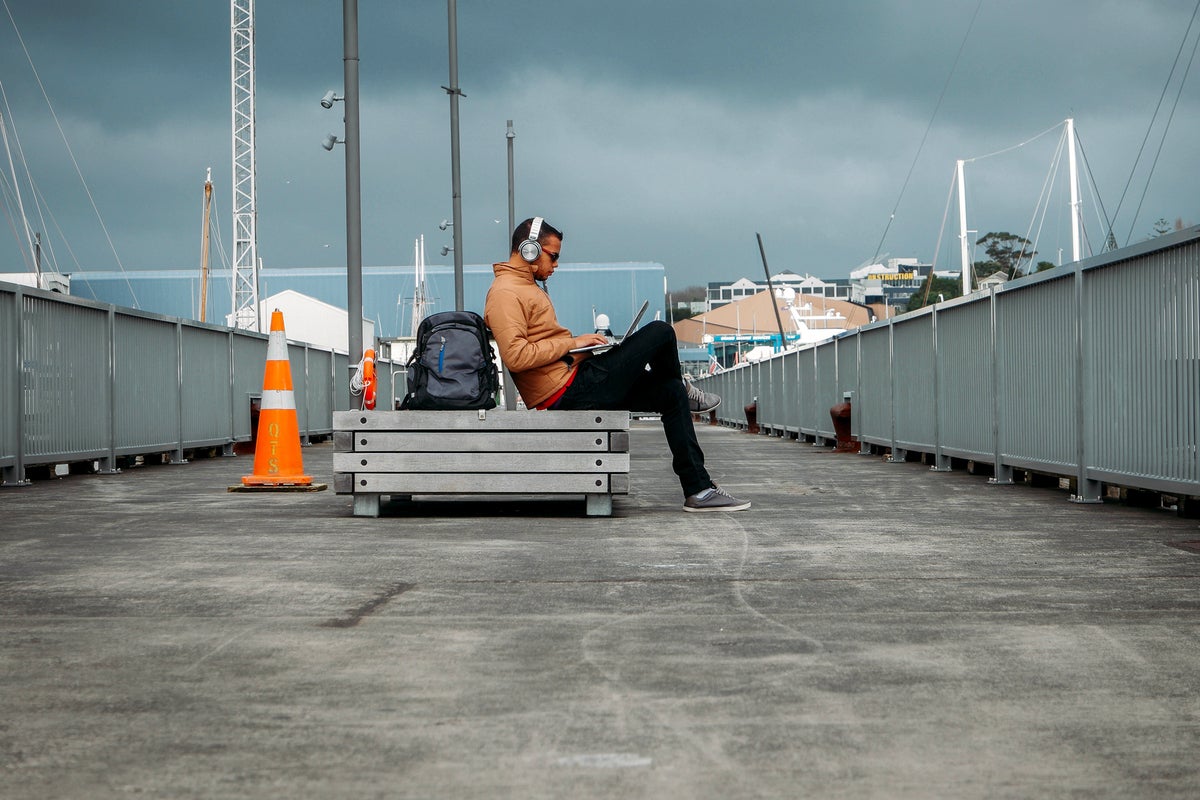As so many companies did at the start of the COVID-19 pandemic, insurance firm Allstate sent tens of thousands of workers home over one weekend. Unlike many other companies, it told the employees to stay home – permanently.
The company’s approach to remote and hybrid work: ask employees what they wanted, and give it to them.
The company either didn’t renew leases or sold off office space, including its 232-acre, two-million-square-foot Chicago headquarters in November 2021. It donated the office furniture to charities, then invested in technology — especially virtual meeting spaces to help employees operate efficiently and inclusively.
 Allstate
Allstate
Allstate CHRO Bob Toohey
Bob Toohey took over as Allstate’s chief human resources officer just under a year ago. In his second week with the company, he made a presentation to the board on his plans for hybrid and remote work going forward, including maintaining and building company culture in a dispersed work environment.
One of his methods for keeping a finger on the pulse on the workforce is through surveys, which he expects to increase over the next year.
The following are excerpts from Computerworld's interview with Toohey:
What percentage of your employees are fully remote today? "I’d say it’s 80/20. So, 80% remote elected to be remote and they don’t have an office desk. So, they go in when needed. And some are remote all the time, and if they need to go in, they can travel to where an office is. A good percentage of our employees could be within 50 miles of where we have an office today. Then there’s a handful of employees who aren’t anywhere near those offices.
“We have main talent centers in Irving [TX], Arizona, Florida and Chicago, India, Ireland,... talent centers we know people can come together in. But when I say remote, I mean those people are fully remote and that’s what they signed up for and we leaned into that.”
How did you determine which office locations to sell off? "First, you determine where people are. So, if people want an office and there’s enough of them, we’ll put one in. That’s something we shared with our employees. And we did that at Northbrook [Ill.]. We got rid of the main campus, and employees there wanted to still have a place to go, so we got them an office. It’s a smaller space, you can fit several hundred people in there at one time, if you choose to, and on any given day that office has gone from 20% occupancy to 60% occupancy. So, we’re going to eliminate offices from where employees aren’t and we’re going to add offices where they are.”
What did you do with the properties? "Some were sold. Some we just didn’t renew the leases. Some we refactored the leases and if we had X amount of square feet and wanted less space, we got a new lease. It’s a mix. Northbrook was sold last year, and that was probably the largest property sale in the company.”
How well did Allstate respond in terms of adjusting to a remote workforce? "One of the things Allstate gets credit for is the speed at which they turned everything on for people working at home. Everyone was sent home, they all thought it was going to be for a week, as we all know, and then there they were.
“People were working, meetings were happening on Zoom and Teams and all the different tools people use, and about halfway through [the pandemic], the company made the decision to survey employees and ask how this is working and what would you like to see post pandemic? Would you like to remain remote, be a hybrid person, or in the office? Lo and behold, the majority said, 'I like this, I want to work at home,' and the company listened and leaned into that. I think that’s how the journey started.
“What we’ve told our workforce, and we’re committed to this, is we’re a flexible environment. We want to make work work anywhere. You can do work anywhere, so how do we make that work and how do we engage teams, create facilitation, create the flexibility. We all believe it’s good to get the teams connected, so the office is not a terrible place.
 Jefferson Santos
Jefferson Santos So, how do you use existing, but diminished office space and what is your remote work policy? "The purpose of [the office] is to get people in to do purposeful work, do things you’d normally do together. Don’t go in and do a Zoom meeting, don’t go in and sit behind a desk for nine hours. Do things that connect people. Also, have social time. Create that intentional way of meeting people and learning and doing other things.
“I want to create a flexible environment. We don’t have rules; we don’t say you have to be in Monday, Wednesday and Friday, or every Monday and Friday. What we’re doing is we take our…leaders and say what are the principles you want to work under? What are the things you want to do, because marketing has a very different need than HR, and legal has a very different need than engineering. So, doing a one-size fits all, which is something we didn’t do before the pandemic, we won’t do now.
"I think it’s a mistake for someone to say everybody get to the office this many days every week. I think you’re going to have unintended consequences from that. The question becomes, why?"
“Everyone’s going to be different. Some groups come in once a week because they want to. Some groups come in once a month. Some groups come in every other week, and they get together with teams and management and they try to collaborate. Then there’s the ad hoc meetings, where we have offices all around the globe.
“We sold our Northbrook [headquarters] campus, which held several thousand employees, but we opened up another, smaller office in that area because people established their lives there, and it’s another place people can go. It’s very different. It’s very collaborative. It’s open space. And, if you want to go to the office today instead of staying home, you can. You don’t have to ask, you sign in and off you go, you’re working in the office.
“Now, what I’m seeing people do is explore what’s the best way to ensure my teammates are there if I go into the office? To me, there’s nothing better than when people self-select in doing this. It happens naturally rather than a rule book we create, because that means it’s work that matters and work they want to do.”
How did tech help and how did it fall short in addressing the problems created by the pandemic? "If you think about what happened, it was pretty good. Technology figured out how to handle the capacity pretty quickly. The videoconference [system] used wasn’t created for the kind of volume we had. So, I think it did a pretty good job.
“I think they did a great job handling external environments, cybersecurity and creating a net around everyone once they were out of the office and working remotely.
What are the collaboration tools you use online, and how do you create a better video experience so if two people are in the same room it doesn’t go back to the old way? "There are technologies out there we’re starting to test. Apps that let you know who’s where so you can get your team in the office. If I want to go into the Chicago office tomorrow morning, I may not want to go in if there’s no one there. So, I may want to send a message. So, how do we create that? No one has cracked that code. I think we’ve done it in segments, and I think we have different tools, but no one has created a way to check and check out and created a community, so you know who’s where and when so I know I have a purposeful reason to go in.
“We will leverage technology for that, but I haven’t found the perfect solution in the marketplace, yet. I think there may be one that if we can get that right, it’ll really accelerate the whole [hybrid work] model. The world is changing, technology is enabling it, and we all need to embrace it.
“It's no different than when we all embraced the smartphone. It allowed us to go to the kid’s soccer game and it let us leave work early because you were still connected. So, how do we take that to where I now have a connected office and not just a connected one-view screen?”
Do you think most companies are embracing remote work? Or, like some industries, such as financial services, they’re demanding employees be back in the office either full time or at least a set number of days? Is that a mistake? "I think every business has to decide what’s best for them. I can’t say it’s a mistake, because if you’re a manufacturing company, you can’t leave everybody at home. If you’re a services organization that’s distributed already, I’m not sure I need you all to come into the office. But, do I think it’s a mistake for someone to say everybody get to the office this many days every week. I think you’re going to have unintended consequences from that. The question becomes, why?
“I want to make sure when we have people come into the office we have a very intentional reason — whether it’s because we’re bringing together development for a day or because we’re going to an innovation seminar; it could be that we’re working on a project development plan. There has to be a really clear reason, not just come in so my employees can be watched.
“We have to trust the work and trust the employees that things are getting done and create that environment that nurtures culture at the same time. I think that’s why people are doing it this way.
“People are beginning to ask themselves: 'Am I going to lose the culture inside my company by the fact that people aren’t here? Is that then telling me something is wrong and something must change?' I don’t think anyone knows the answer. I think everyone is trying to figure that out. I was just with a bunch of cohorts of CHROs and we had this very discussion. We’re all in the [place where] we know it’s going to change, but everybody’s learning what’s best. I think the 'must come in a certain number of days' starts with ‘you must come in four days,’ then if goes to ‘eh, just come in three days,’ and then it’s ‘hey, how about two days…just come in!’
“We’re taking the reverse approach. We want to make it where you want to come into the office. And, I think I’m seeing more of a pull effect versus a push effect, because it has purposeful meaning. There’s rationale to it. And when that happens, I’ve yet to see people who go into the office who are miserable. They’re happy. They’re seeing their co-workers. They’re connecting. They’re doing all the things they used to do, but what they know is they don’t want to have to do that every day.
“I’m pretty confident people are happy to see their co-workers, but I’m also confident they want that environment to be flexible and know how to do that. And flexible means they’re working at different times. Some have to go to child care, some have to go to an appointment and they’re able to do those things, but they’ll get back online later that night. We have to make sure we find that balance and create the right synergy. We’re going to continue to test and learn for that environment, too."
How do you create or sustain a company culture when your workforce is hybrid and remote? “We keep in touch with employees. We survey them, too. We ask how they’re doing. We have to use new technologies to see how they’re doing and focus on wellbeing and how best to support your team around the world.
“I’ll use Allstate as an example. We built a company around a very strong culture of having a shared purpose. Having that foundation has made it possible to continue that journey and maintain that culture.
"The purpose of [the office] is to get people in to do purposeful work, do things you’d normally do together."
“And the culture is all about how do you work, how do we interact with each other and what do you do? So, I’m very confident we’ll continue that journey and build on that foundation; it’s just going to be learning how to work together differently. One thing we’re going to begin doing is ongoing pulse surveys. I use the term 'test and learn.' So, how are things going for you? How can we improve?
“Another opportunity to improve culture is three pronged: How do I work? What are my opportunities? And, am I in a belonging culture? How do I work? How does my work get done. Is it flexible? Do I have to tools I need? Can I connect and contact people?
“Am I getting opportunities to grow, have an impact and develop? I think now more than ever we have a chance to do that — unlike any other time before, because we don’t have to relocate somebody. I don’t have to say, ‘I’d love to put you in this job, but it’s in Chicago and you live in Boston.’
So, the aperture to leverage everybody’s capabilities…and help them find new pathways and possibilities is exciting. We have many opportunities to ... help people grow and have an impact. And with that, you have a much more diverse and better culture — diversity from a standpoint that it’s part of our culture and belonging and we’re able to let people try new jobs.”
What are your biggest concerns with remote employees going forward? "Our biggest opportunity is you have different segments of your organization that were already here [before the pandemic], and they have their connections — or as I like to say, their folks. You want to make sure new hires get connected and become part of the bigger culture. So that’s something I think about all the time. How do I make sure you get the same connection that someone who’s been here 10 years has?











